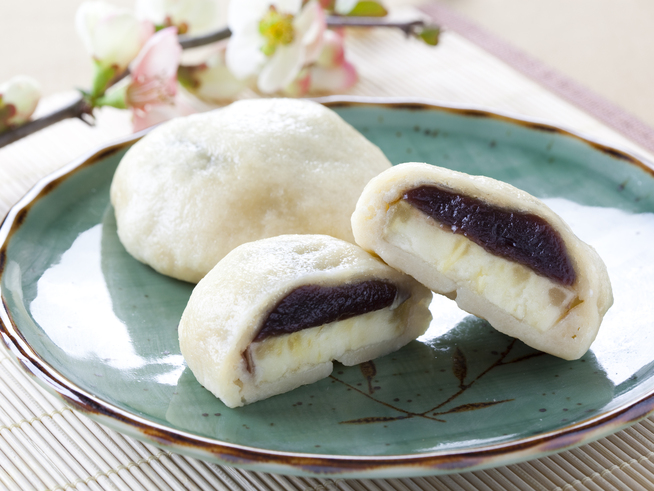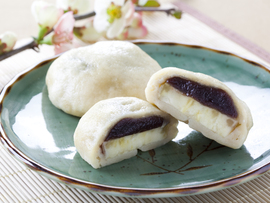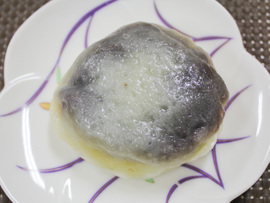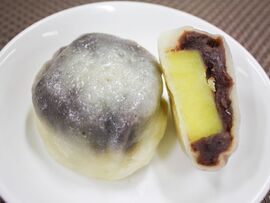
Ikinari dango

KumamotoIkinari dango
Classification (Large)
Others
Classification (Small)
Japanese sweets
Main ingredients used
Sweet potato, wheat flour, glutinous rice flour, red bean paste, salt
When using downloaded images, please read the "Terms of Use" and clearly state that the source of the image is "Traditional Foods in Japan" by the Ministry of Agriculture, Forestry and Fisheries.
If the photo credits is stated, please include it as well.
Example of description
of the photo credits
Example of description when the photo credits is not stated
Source: "Traditional Foods in Japan" Ministry of Agriculture, Forestry and Fisheries
Example of description when the photo credits is stated
Source: "Traditional Foods in Japan" Ministry of Agriculture, Forestry and Fisheries
Photo credits:xxx

Photo credits:Kumamoto Prefecture
This image isunavailable.
Region of inheritance
All regions of Kumamoto Prefecture
Product overview (special characteristics and types)
Ikinari dango are dumplings made from wheat or glutinous rice flour. They are filled with karaimo (Satsumaimo sweet potatoes) and red bean paste, then steamed to make a sweet, simple treat. In Kumamoto Prefecture, sweet potatoes are also called “karaimo” or “kansho.” Throughout the prefecture, especially in the outskirts of Mount Aso’s caldera where the agricultural fields are concentrated and where the volcanic ash provides excellent drainage, sweet potatoes thrive.
Sweet potatoes used to only be consumed in the fall, when they are in season. Now, they are also available as a frozen food, and can be enjoyed all year round.
In Kumamoto dialect, the word for dumpling is pronounced “dago” as opposed to “dango” in Standard Japanese, so the food is also called “Ikinari dago.”
History and culture
The word “Ikinari” in Ikinari dango comes from the word that means “easy; fast; immediately” in Kumamoto dialect. While it indicates something which can be made easily in a short time, it also means something that can be served to surprise guests. That is how the name of the food came about.
In the past, when rice was a precious commodity, the dumpling was made only with wheat flour and the filling was kept to only sweet potatoes. It was a humbler food than it is today, which mainly sees Ikinari dango produced with glutinous rice flour and a red bean paste filling. The fluffy sweet potato center, the sweetness of the bean paste, and the slight saltiness of the soft, chewy dough has gained widespread popularity.
Sweet potatoes have been cultivated in Kumamoto Prefecture since olden times and they have been incorporated into various dishes that have been passed on in the local food culture until this day: ganeage, in which julienned strips of sweet potato are dipped in a batter before deep-frying, and nettabo, where steamed sweet potatoes are combined with mochi rice cakes and sprinkled with kinako bean powder, are examples of this.
Ikinari dango was usually eaten as a snack during the fall when sweet potatoes were harvested and also at home during sweet potato season, but now it is available on any day of the year through specialty stores, Japanese wagashi sweet stores, and street vendors. With its time-proven formula of just the right sweetness and mellow taste, it is popular both as a tea refreshment and a snack for children. In recent times there has been increased variety in its offerings, with Japanese mugwort or brown sugar mixed into the dough, kinako bean powder toppings, purple sweet potato fillings, and chestnut and walnut fillings.
Production method
Wheat flour, glutinous rice flour, salt, and sugar are mixed together before being kneaded into a soft, supple dough. The sweet potatoes are sliced and together with the red bean paste are wrapped in the dough before steaming.
Conservation and succession efforts
Ikinari dango is known throughout Japan as a souvenir of Kumamoto and there are numerous specialty stores around. It is often made as an assigned dish in community cooking classes, and many people make it at home as well. It is also served as a dessert at school lunches.
Main consumption method
It is served as a snack, straight out of the steamer and piping hot. For souvenirs, it is available as a frozen food that is to be reheated in a microwave or a steamer. It may also be enjoyed toasted in an oven.


